An Illustrated History of Old Sutton in St Helens, Lancashire
Part 71 (of 95 parts) - Memories of Sutton Part 21
Compiled by Stephen Wainwright ©MMXX
‘My Apprenticeship – Some Memories Part 1’ by Ken Bailey Jnr.
Introduction – The photography exhibition by writer and photographer Alan Smith, staged at the World of Glass in St. Helens between January and March 2016, marked 25 years since the closure of Sutton Manor Colliery. I took pleasure in visiting the exhibition and this gave me cause to remember and reflect upon some of my time within the mining industry.
Images from Alan Smith’s exhibition ‘When the Pit Closed’ at the World of Glass in St.Helens

Alan Smith’s exhibition ‘When the Pit Closed’ at the World of Glass

Images from Alan Smith’s exhibition
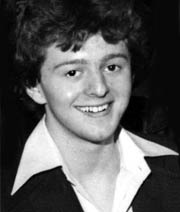
William (Bill) worked at Lea Green Colliery and Parkside Colliery; Norman was at Ravenhead Colliery; John (Jacky) was at Ravenhead Colliery & Sutton Manor Colliery and Kenneth (Ken) who was my father, worked at Lea Green, Parkside Colliery and finally at Sutton Manor Colliery, where he became a Colliery Deputy. My brother Jeff and I worked at Sutton Manor and a cousin Ged was employed at Bold, until both collieries closed.
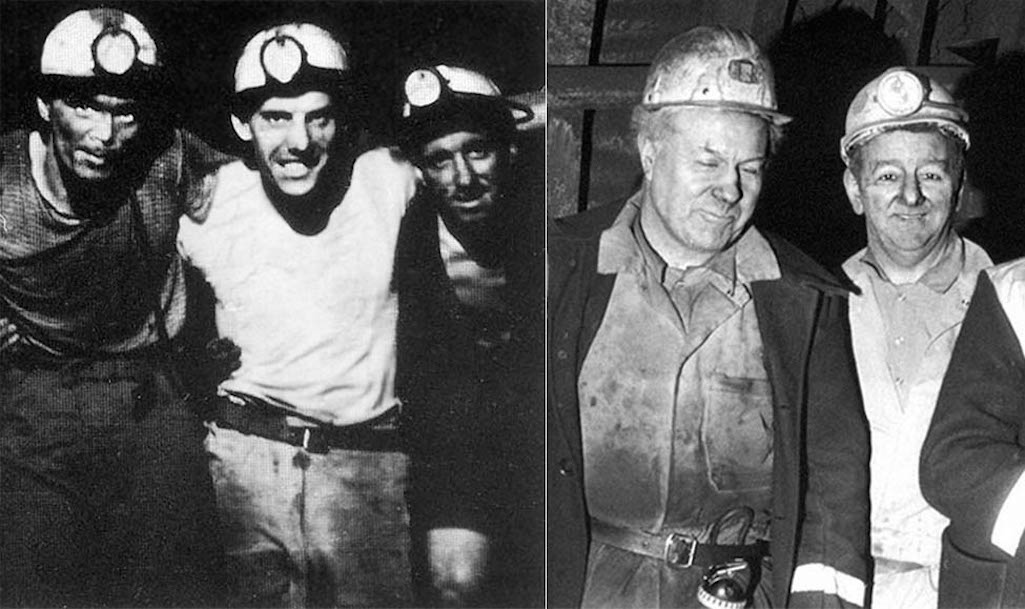
Left: Bill Bailey at Lea Green Colliery on the right of the photo; Right: Ken Bailey Snr. at Sutton Manor also on the right

Left: Bill Bailey on the right; Right: Ken Bailey Snr. also on the right

Left: Bill Bailey on the right; Right: Ken Bailey Snr. is also shown on the right
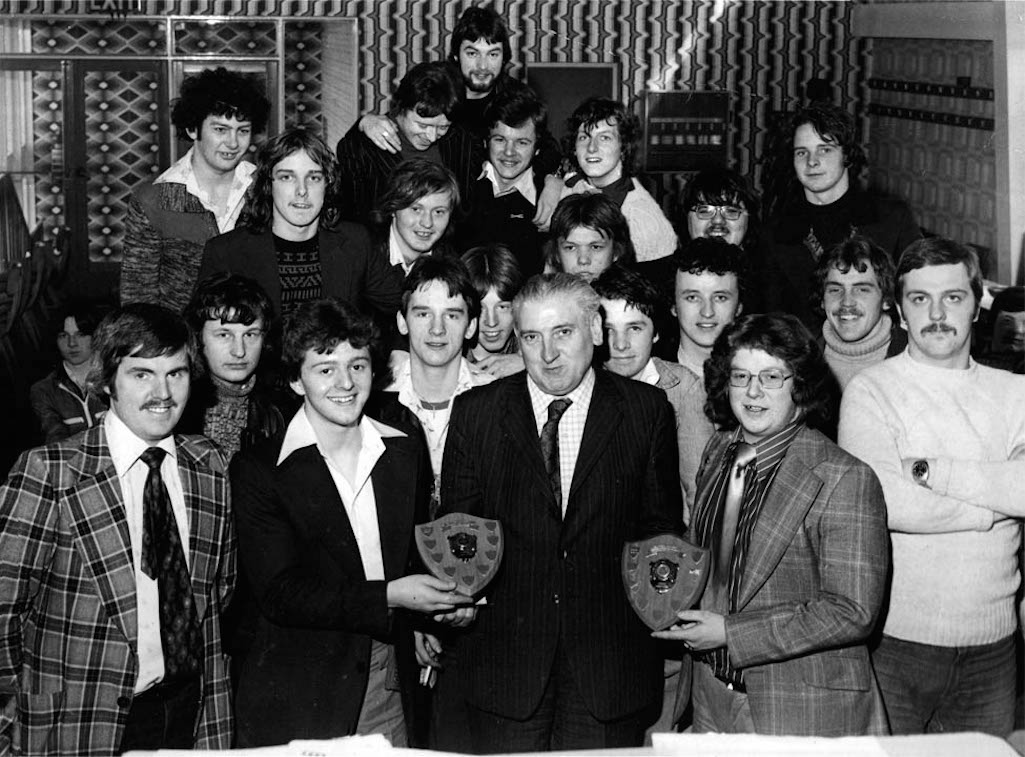
Front Row L-R: Brian Salkeld (Colliery Training Officer); Ken Bailey; Cyril Willdig (Coal Industry Social Welfare Organisation); Stephen Friar; John Cunningham; Second Row: Stephen Richardson; Raymond Stewart; David Sephton; David Ashton; Sean Kilgannon; Geoff Thompson; David Scott; Stephen Porter (partly out of shot); Third Row: Colin Briscoe; David Knowles; Joseph Alker; David Livesley; Tony Marsden; Trevor Parr; Quartet at Rear: Mike Orchard; Peter O’ Brien; Colin Walker; Stephen Owen.
The lads were a cross section of apprentice fitters, electricians and mining craft. The latter was the NCB’s scheme to produce future colliery deputies / overmen and managers. By the time Sutton Manor colliery ended production in 1991 we were in our early 30s and this generation had become the mainstay of the colliery’s workforce. Such was the nature of the coal industry, with one generation succeeding the next. I think this kind of workforce succession in part sowed the seed and generated over time the camaraderie that ex-miners describe when reminiscing about their time working “down pit”.
I recall us apprentices being encouraged to organise what became called the Sutton Manor Apprentices Movement, the notion being that we would have a committee and organise meetings with guest speakers and social events. I think the background agenda being that by undertaking such we would develop collaborative working experience, knowledge and skills that would complement our trade training and future underground team work skills.
Perhaps one of the great strengths of Britain’s then nationalised industries was its investment in training for its workforce and the opportunities these provided for personal development. At Sutton Manor Colliery you could see, give or take a couple of years, the different employee generational intakes in evidence, with lads being mentored, coached and socialised with a work ethic sense of purpose that would stand them in good stead for the future.
On the 10th March 1975 I commenced employment with the National Coal Board (NCB) at their Old Boston training centre in Haydock. I was one of many young teenagers starting their first real job and entering a new world of work - so different from the schools we had recently left. We had to undertake 60 days training as a mining trainee, with a minimum of 20 days underground training. The first two weeks’ induction covered a lot of health & safety. We watched NCB safety awareness films that re-enacted accidents and gave a strong message. Firefighting training was very good learning about the different types of extinguishers and the kind of fires they should be used on. All of us had to use them on real fires set in a designated area under the instructors’ supervision.
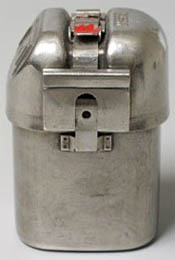
What I now see as a mining work socialisation process was being instilled in us, both formally and informally, by our instructors. They would take us through the practicalities of tasks ‘step by step’ and highlight risks both real and potential based upon real life working experiences. All the lads in my group soaked up the stories and sometimes ‘the tales’ that we were told. Again this was part of the pit socialisation induction, young lads figuring out fact from fiction - they made us think!
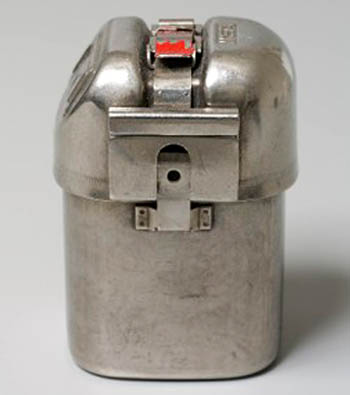
Miners self-rescuer carried on the belt
Stan remains involved with Rugby League to this day and has been at St. Helens Rugby League club for the last 20 odd years or so as ‘Saints Kit man’. As a season ticket holder I often see him on match day in the distance on the pitch preparing the players training gear. Whenever I read or hear the Saints players refer to him it reminds me of the time I was one of his many mining trainees and the impression he made.
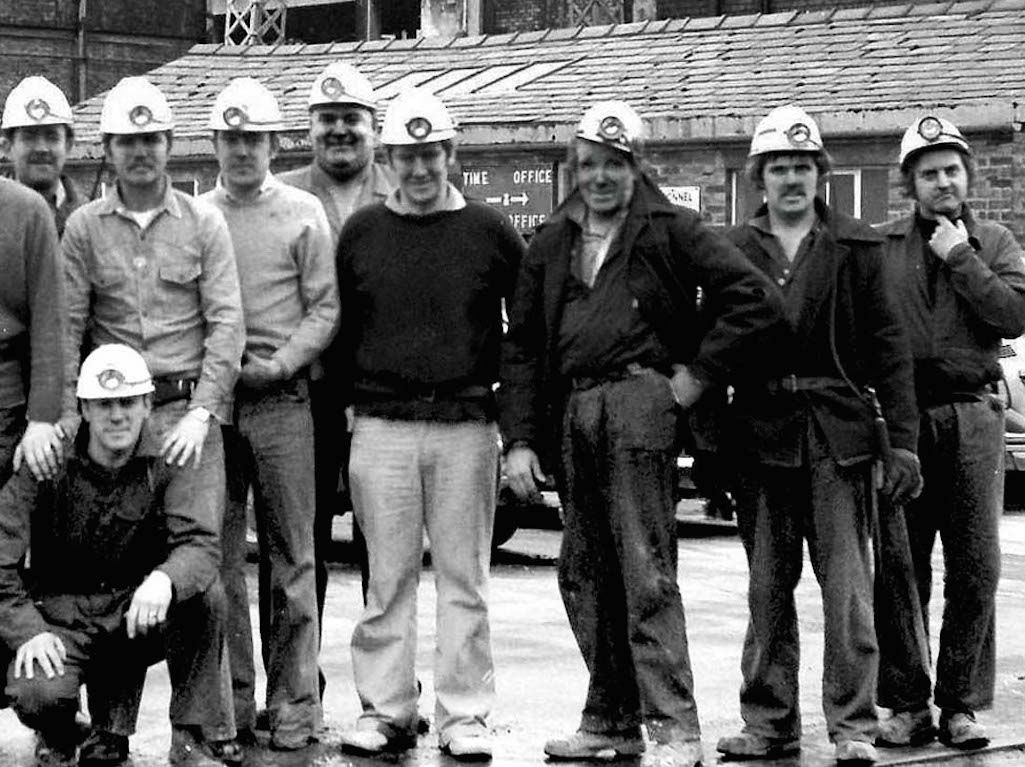
Tutor Tommy Peet is pictured on the far right of this 1976 photograph standing next to Brian Salkeld

Tommy Peet is on the far right standing next to Brian Salkeld

Tommy Peet is pictured on the far right
Dick Gibson – Dick was the Training Centre’s first aid guru. I think he was a senior and longstanding member of the St. John’s Ambulance Service. I don’t think anyone ever saw him without a St. Johns First Aid book in his hand. What Dick didn’t know about first aid wasn’t worth knowing. Dick was another skilled communicator and could illustrate first aid techniques with real life experiences and approaches.
Old Boston Training Centre – My first impressions of Old Boston was how busy it was and the numbers of lads constituting the various groups and classes. There were apprentice electricians and fitters of different yearly intakes and at various stages in their respective apprenticeship training. There were us mining trainees in our groups and other employees on a variety of refresher courses from all over our North West Area. In part it felt like a natural progression from leaving school except our new uniform was overalls, boots and helmets! We had real jobs and were proper grown-ups now!!!
The Dialects - The lads came from across the area; St. Helens, Leigh, Wigan, Tyldesley, Atherton, Warrington, Manchester, Huyton and Liverpool. At the time in 1975 we had the following working collieries: Sutton Manor, Bold, Cronton, Parkside, Parsonage, Bickershaw, Golborne, Agecroft, Haig, Hapton Valley and the Walkden Yard engineering workshops. We all spoke English but in our own unique ways. It was kind of like an NCB North West Area ‘United Nations’, with a range of northern dialects to be hold, but eventually we could all speak ‘Pit’!
The Canteen – What a busy place; Come break and lunch times there was a succession of lads who could all eat for England. I recall there being a production line of lads ordering and being served the number one dish ‘cheese on toast with baked beans’. You could keep the nation going with that and those hard working canteen staff ladies certainly did that.
Pass this test and you can apply for an apprenticeship! – In the early days of the induction we did a test paper. I don’t recall the exact content of the test but I think it was probably mostly mathematics and English based. We were told that if you got enough marks then you could apply for an apprenticeship. Some time passed and I didn’t hear anything about the test results. I decided to ask how I had got on and went to see the training centre manager and asked if he could tell me how I had done as I would like to apply for an apprenticeship. I was asked to wait while he checked.
Not long later he returned and said I had gained enough marks. He went on to explain and tell me about the Mining Craft Apprenticeship scheme. From memory this scheme seemed to be a relatively new concept and aimed at producing future Colliery Deputies and Overmen. I applied and was told at a later date that I had been accepted onto the course and would be sent to college later in the year. The Mining Craft Apprenticeship scheme extended over a 3 year period with this basic structure:
1st Year of the Scheme: Induction - 10 days at training centre
Preliminary basic training – Mining 30 days, Engineering 20 days at training centre and or technical college
Basic engineering training – 60 days at training centre
Proficiency tests
Close personal supervision underground – 20 days minimum
Training in underground operations leading to job rotation
Academic course 4 / 6 week study blocks at technical college - Mining General
2nd Year of the Scheme: Non– vocational course – one week, organised with the help of the Coal Industry Welfare Organisation (CISWO)
Job rotation – both surface departments and underground occupying most of the second year
Coal face instruction widening and supporting job rotations – 20 days
Academic course 4 / 6 week study blocks at technical college - Coal Mining Craft Certificate
3rd Year of the Scheme: Coal face training
Basic coal face training under close personal supervision – 100 days minimum
Improvership – 40 days minimum (to complete the apprenticeship)
Academic course 4 / 6 week study blocks at technical college - Mining Technicians
Starting Work At Sutton Manor – Following completion of my basic training at Old Boston I started at Sutton Manor Colliery on the 9th June 1975. This is where I first met Brian Salkeld, the Colliery Training Officer. Brian made us welcome and organised the taking of us underground, allocating and introducing us to our supervisors. All new starters had to do 20 days underground under close personal supervision. I was placed with a chap who worked on erecting ‘Stone-Dust Barriers’. These barriers were basically wooden shelves spanning the tunnel with small 12 inch boards laid across them and stone-dust was spread on top of the boards. The notion being that in the event of an explosion, the inert stone-dust would be scattered into the airway smothering and extinguishing the explosive flame and minimising a rolling coal dust explosion throughout the mine workings. The number and placing of these barriers was dictated by mining health and safety legislation.
I remember thinking this wasn’t like the training gallery, but that wasn’t really a surprise. The nature of working on the stone-dust barriers meant that we moved to different districts / areas of the pit, so it was a good orientation. Following my initial 20 days I was deployed to a haulage team transporting supplies by a rope haulage system. This job sounds simple when described but I learned a lot from watching and listening to the experienced lads who could make things look simple. I remained on the haulage up until I commenced my Mining Craft Apprenticeship.
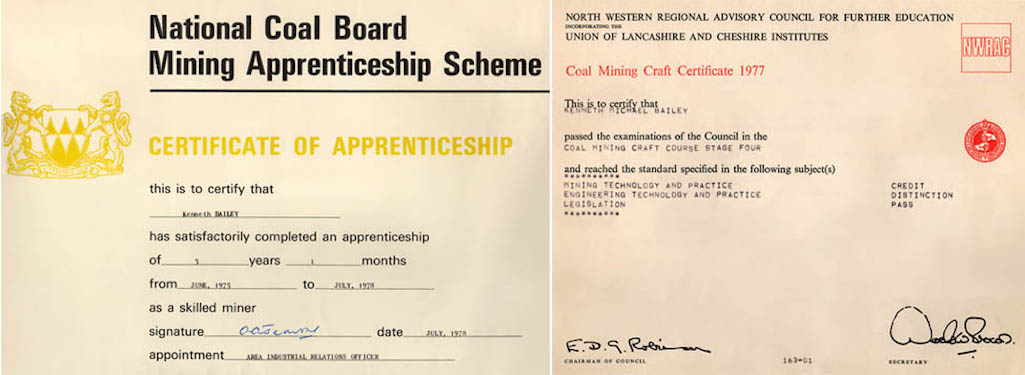

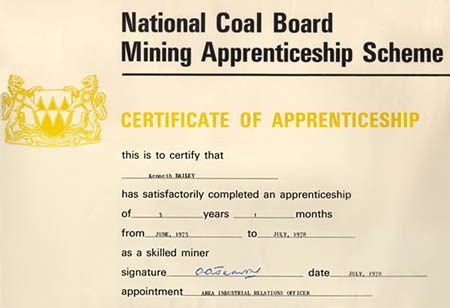
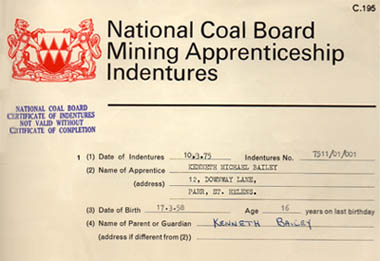
Engineering Technology and Practice
Legislation 1977 – 1978 Mining Technicians 1978 – 1980 Technician Education Council Certificates which included: Mining Techniques and Practice
Mining Legislation – Mines and Quarries Act
Engineering Principles
Mathematics
General and Communication Studies
Course Tutors (Some memories) – The teachers were mostly former mining men, ex-managers and engineers.
Alistair MacMillan (Mining Engineering) – The key thing I remember about Alistair, a.k.a. ‘Mac’ to his students, was his enthusiasm for his subject. His mild Scottish brogue accent seemed to make his examples and explanations of mining experiences and practice more interesting. His volition was evident by the way he organised visits to other collieries. One that stands out was a trip to Hapton Valley Colliery in Burnley to see the use of a face plough. We had learned about this in theory but seeing it in real life was something else. The face it worked on was really low, which is why they opted for using a face plough.
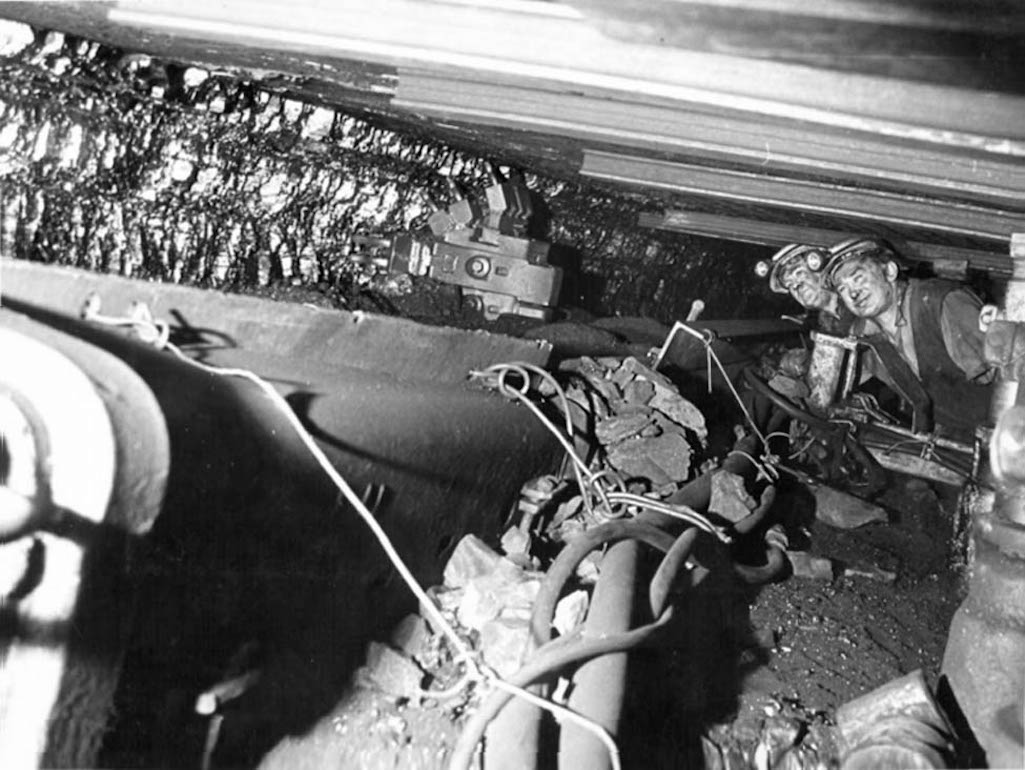
Coal face at Hapton Valley Colliery in Burnley - Alistair MacMillan organised a visit for NCB apprentices

Alistair MacMillan organised a visit to Hapton Valley Colliery

Hapton Valley Colliery in Burnley
Roy Hughes (Mechanical Engineering) – At the time Roy seemed fairly young to be one of our teachers but I found Roy had a real down to earth approach. I discovered that Roy had been an apprentice and qualified fitter at Sutton Manor Colliery as people there remembered him. I remember Roy describing that he had once not done too well with some exams and had just managed to get a pass. This seemed to be a wakeup call and he said he learned the need to knuckle down to his studies that would in due course secure and enhance his future.
I could relate to this as I also had a similar experience and although some of my peers seemed to be able to grasp things with ease, I knew that I had to work harder to keep up and achieve my work career goals. In short I always had to ‘burn the midnight oil’ reading and revising. I also recall Roy presenting and explaining engineering calculations, the mathematics of which I had generally struggled with. But the way Roy explained and broke down the formulas and calculation process was a ‘light bulb’ moment for me and I could now understand and do these ‘hard sums’. I will always credit Roy with this. There were of course quite a number of other tutors who all had their merits and my mind can picture them.
A couple of topics that stand out are Ventilation Calculations and Mining Legislation, plus the Mines & Quarries Act and also noting the then new Health & Safety at Work Act (1974). By the way the use of chalk on blackboard was the key tool for teachers at the time, computers and power point presentations were stuff of science fiction! I recall one of our tutors would enter the classroom, begin writing in chalk at the top of the blackboard, we would copy the text in our notebooks and when he got to the bottom he would rub out the top part and begin again! This process went on for the full lesson; at times it was a challenge to keep up with him. When doing ventilation calculations the tutor would create a formulation that seemed to take the whole lesson to calculate. I guess the repetition involved drilled the knowledge and understanding into us; it also kept us quiet!
Teaching and the learning of mining legislation, the Mines & Quarries Act, was I believe a challenge for both the tutor and student. It could be a dry subject and we needed to go through our mining regulations and Mines & Quarries Act books with the tutor leading. We would go through each chapter and underline key words in each sentence by way of helping us soak up the information. But importantly the tutor would illustrate some key aspects by describing where, how and why the regulations had originated from, e.g. mining disasters. It would sometimes be perhaps dramatically said that the mining regulations were ‘written in blood’, basically because much of the laws and regulations had come about due to fatal or serious injuries to miners. That made some real sense to me and it can be annoying today when I hear people in general society complain about Health & Safety issues or is that just a measure of the influence of my mining education?
Practical Training: 1975 – 1977 – 4 / 12 week pit time job rotation across different colliery departments:
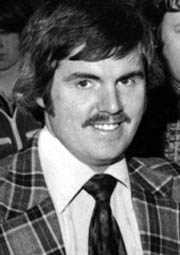
This is not an exhaustive list as the training office also assisted the time office staff on pay days, providing authorisation slips to men who required a pay receipt to get their wages. (Note; most men were paid by cash in weekly pay packets at this time). Also the Training Officer ‘Brian’ became the public face of the colliery in so far as the number of visits he was charged to facilitate. Many different groups from outside mining were interested in seeing a working coal mine. It was an eye opener for many.
At the time of my placement I do recall a new type of training record document being introduced and data from men’s old record forms needing to be re-written onto the new forms. The interesting thing for me was the number of different collieries that many of the older men had worked at. It seemed that they had left a pit on a Friday and started a new pit on the Monday. Apparently this was not unusual in the 1950s and 1960s with men often moving and transfer for better opportunities, e.g. to gain more pay working on coal faces or in tunnelling where there were better geological conditions. Those were certainly different times for jobs compared to the way things are at the time of writing!
Key learning for me was the importance of good professional training, the competences it engendered and its relationship to promoting and maintaining a safety culture. I always felt Brian was a strong advocate for this philosophy, modelling a diligent and professional approach to his role. Subjectively and thinking back to what my peers described from their collieries, I think Brian set a standard for his job role. I was and am very appreciative of his support during my apprenticeship.
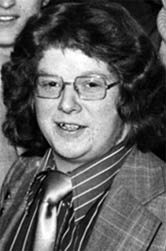
When I was appointed as a Colliery Deputy and had responsibility for recording men’s attendance and allowances, I made sure I was diligent in recording such. Everyone wants to feel the security of being paid correctly. I do recall Stephen Friar being an administration / business course apprentice during this time. I think Stephen eventually became in charge of the time office. Stephen was always helpful and supportive. He was also a keen ‘Saints’ fan, so couldn’t go wrong there!
Materials / Stock / Cost Control - Spending time with the Materials Officer allowed me to gain an understanding of supplies ordering; prioritising, costs and control. As a Colliery Deputy background knowledge and understanding gained from this placement informed my decision making regarding efficacy of ordering quantity and prioritising supplies for my district.
20 Days Coal Face Apprentice Induction Training – 1976 – This training allowed me access to the coal face and to perform basic tasks relevant to my job rotation placements.
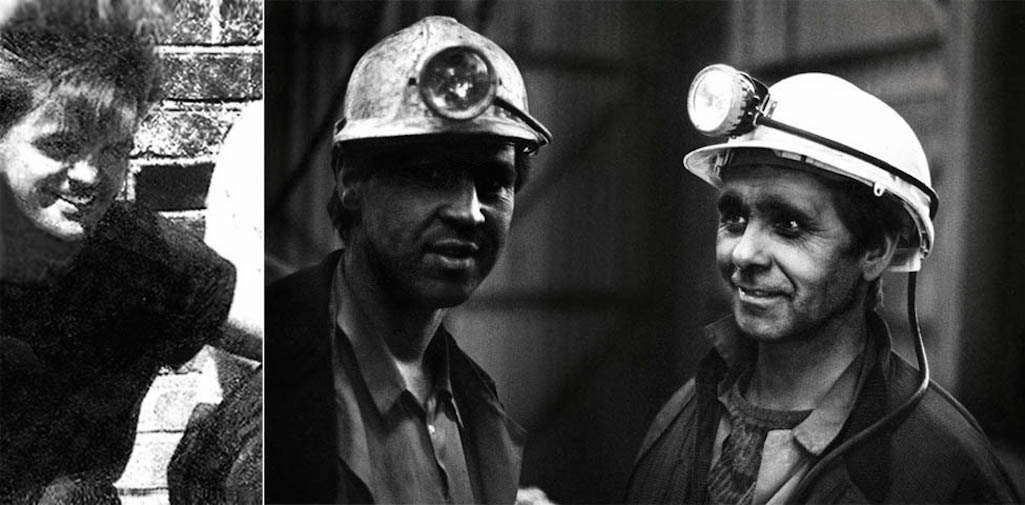
L-R Kevin Mather, Kenny Brownbill and Alan Greenall, members of the colliery’s Methane Drainage Team

Methane Drainage men Kevin Mather, Kenny Brownbill & Alan Greenall

Methane Drainage men Kevin Mather, Kenny Brownbill and Alan Greenall
1) Mines ventilation airflow system - Calculating and monitoring air quantity, quality and speed. This involved monthly reviews measuring airflow, using instruments e.g. the anemometer and taking air samples in small rubber bladders. These were sent to the area laboratory for analysis. The use of auxiliary fans to ventilate tunnel developments was very important. The team would advise management on the use of these, providing ‘ventilation rules’ for their use.
2) Methane Drainage – This was the process of safely extracting methane gas from the strata. As the coal face is cut it releases methane into the air. This is also true for the seams above and below the current workings. As the strata is disturbed, methane is released and finds its way into the current workings increasing risks. To manage these risks the methane drainage team would follow the workings, and using a specialised boring machine would bore holes mostly above and sometimes below the coal seam being worked. These 3 inch diameter boreholes would be connected to a 10 inch diameter pipe range that ran all the way back to the methane pumping house on the surface, where the gas could be safely discharged or in Sutton Manor’s case sold commercially and so support the colliery’s cost effectiveness.
My placement with the staff of this department was an excellent learning opportunity. They encouraged participation and readily shared knowledge, experiences and skills, instilling confidence in a most natural way, which was always appreciated. I do recall their humour as being extraordinary, which sometimes belied the knowledge and skills held by these good folk.
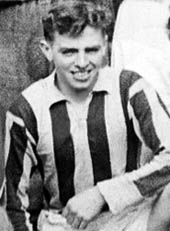
Safety Department – During my placement within the department it had two staff, Jock McPhail – Safety Engineer and Alan Davies – Safety Officer; they had key roles in advising the Colliery Manager on safety design standards and legislation, the investigation of accidents or near misses and the collating of accident statistics. They were of course a source of advice to all across the colliery site.
Dust Control – The Dust Control Officer was Keith Wall and his sampling team were Joe Lucas, Tommy Gregson, Norman Johnson and Roy Davies. This department monitored respirable dust levels using sampling machines located at key points near to the coal faces and tunnel developments. The department would collate the results of the samples to ensure the dust levels were within the legal range and if not actions would be taken to address the problem areas e.g. install additional dust suppression water sprays over conveyors, review machine cutting picks and their water spray maintenance regimes and amend as required.

In the second part of my apprenticeship recollections, I will discuss working with the shafts men on top of the cage, residential courses, the colliery first aid team, coal face training, colliery deputy training and becoming a deputy, gas testing, shot-firing and my reflections on working at Sutton Manor Colliery from 1975 to its closure in 1991.



